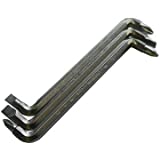pucho812
Well-known member
wanted to pull away from the covid stuff and talk some normal for a minute, hell a good ol pucho rant to boot. Why do some companies design gear in such a way so that basic servicing is nearly impossible?
Pulled apart the studios DBX160S for what should be a quick and easy replacement of a meter bulb that is out. Nothing quick or easy about it.
For starters the design is laid out in such a way that if you need to replace the right meter or bulbs for that meter, you have to either disassemble the power supply, removing the PSU chassis so you have access to the meter or you remove the front panel. I assume the later is what they had in mind. There is no way to get in there with a screw driver if you just remove the lid. Then once you can gain access, there is a small circuit board that is attached via standoffs to the front panel located right behind the meter that the meter itself is clipped onto and soldered to making it even more of a chore just to get at the bulb/bulbs and replace the bulbs. After a long time of what the and why the, the mission got aborted and a new attempt will be done later after some thinking. What is most frustrating is that there is no mention of what bulbs are used to illuminate the meter at all in any manual I have found online. While I did get help from our DIY family here, I am surprised there is no mention of the bulb type in the manual. It's as if they really want you to send it in for something so minor and silly. Since at the moment the unit is working otherwise, this gets moved to the low priority list. While I do like all the rack gear to illuminate because it looks nice this can wait, or I could easily unhook the bulbs from the left meter so that it looks the same on both sides.
I should take some photos.
Here is a photo to show what I am referring to.
Clearly can see the PCB behind the meter and how it attaches to the front panel, clearly can see the right meter and not having clearance to get the PCB out to get the meter out to replace the dead bulbs without some major disassembly.
Pulled apart the studios DBX160S for what should be a quick and easy replacement of a meter bulb that is out. Nothing quick or easy about it.
For starters the design is laid out in such a way that if you need to replace the right meter or bulbs for that meter, you have to either disassemble the power supply, removing the PSU chassis so you have access to the meter or you remove the front panel. I assume the later is what they had in mind. There is no way to get in there with a screw driver if you just remove the lid. Then once you can gain access, there is a small circuit board that is attached via standoffs to the front panel located right behind the meter that the meter itself is clipped onto and soldered to making it even more of a chore just to get at the bulb/bulbs and replace the bulbs. After a long time of what the and why the, the mission got aborted and a new attempt will be done later after some thinking. What is most frustrating is that there is no mention of what bulbs are used to illuminate the meter at all in any manual I have found online. While I did get help from our DIY family here, I am surprised there is no mention of the bulb type in the manual. It's as if they really want you to send it in for something so minor and silly. Since at the moment the unit is working otherwise, this gets moved to the low priority list. While I do like all the rack gear to illuminate because it looks nice this can wait, or I could easily unhook the bulbs from the left meter so that it looks the same on both sides.
I should take some photos.
Here is a photo to show what I am referring to.
Clearly can see the PCB behind the meter and how it attaches to the front panel, clearly can see the right meter and not having clearance to get the PCB out to get the meter out to replace the dead bulbs without some major disassembly.





























![Electronics Soldering Iron Kit, [Upgraded] Soldering Iron 110V 90W LCD Digital Portable Soldering Kit 180-480℃(356-896℉), Welding Tool with ON/OFF Switch, Auto-sleep, Thermostatic Design](https://m.media-amazon.com/images/I/41gRDnlyfJS._SL500_.jpg)




